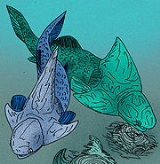
Groenlandaspis
Encyclopedia
Groenlandaspis is an extinct genus of armored placoderm.
Groenlandaspis was a member of the Order
Arthrodira
, the most successful group of placoderms which also included the 10 metres (32.8 ft) superpredator Dunkleosteus
. As with all other arthrodires, Groenlandaspis had a joint in the back of its head with its thoracic armor
, allowing for its head to be thrown back, increasing its gape. However, as its head is somewhat compressed in comparison with many other arthrodires, and as the dorsal side came to a low, pyramid-like peak, it is believed that Groenlandaspis could not throw its head back very far. It was a relatively small fish, only 7.5 centimetres (3 in) in length, and lived on the ocean floor, where it is thought to have fed on either very small prey, or detritus
; the small dental plates in its mouth strongly suggest that it was incapable of tackling large prey.
This highly successful placoderm genus has been found throughout the world, though the first fossils were found in Greenland.
Groenlandaspis was a member of the Order
Order (biology)
In scientific classification used in biology, the order is# a taxonomic rank used in the classification of organisms. Other well-known ranks are life, domain, kingdom, phylum, class, family, genus, and species, with order fitting in between class and family...
Arthrodira
Arthrodira
Arthrodira is an order of extinct armoured jawed fishes of the Placodermi class that flourished in the Devonian period before their sudden extinction, surviving for about 50 million years and penetrating most marine ecological niches....
, the most successful group of placoderms which also included the 10 metres (32.8 ft) superpredator Dunkleosteus
Dunkleosteus
Dunkleosteus is a genus of prehistoric fish, one of the largest arthrodire placoderms ever to have lived, existing during the Late Devonian period, about 380-360 million years ago.This hunter, measuring up to and weighing , was a hypercarnivorous apex predator...
. As with all other arthrodires, Groenlandaspis had a joint in the back of its head with its thoracic armor
Thorax
The thorax is a division of an animal's body that lies between the head and the abdomen.-In tetrapods:...
, allowing for its head to be thrown back, increasing its gape. However, as its head is somewhat compressed in comparison with many other arthrodires, and as the dorsal side came to a low, pyramid-like peak, it is believed that Groenlandaspis could not throw its head back very far. It was a relatively small fish, only 7.5 centimetres (3 in) in length, and lived on the ocean floor, where it is thought to have fed on either very small prey, or detritus
Detritus
Detritus is a biological term used to describe dead or waste organic material.Detritus may also refer to:* Detritus , a geological term used to describe the particles of rock produced by weathering...
; the small dental plates in its mouth strongly suggest that it was incapable of tackling large prey.
This highly successful placoderm genus has been found throughout the world, though the first fossils were found in Greenland.

